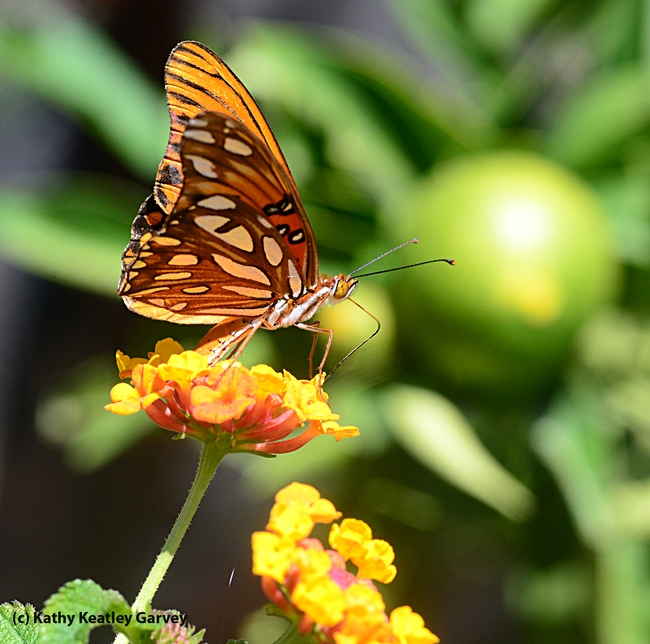- Author: Kathy Keatley Garvey

It apparently originated during World War II. Remember the 1942 film, "The Flying Tigers," starring John Wayne as Capt. Jim Gordon?
John Wayne, aka Jim Gordon, asks a Rangoon hotel clerk about a missing plane: "Any word on that flight yet?"
The hotel clerk replies that Japanese aircraft attacked the plane, but "She's coming in on one wing and a prayer."
Then there's the 1944 film, "Wing and a Prayer," about "the heroic crew of an American carrier in the desperate early days of World War II in the Pacific theater" (Wikipedia).
Fast forward to today, but this time with migratory monarchs. It seems that, they, too, fly on a "a wing and a prayer."
Over the last two months, we've seen dozens of migratory monarchs-often four or five at a time--stop for flight fuel in our 600-square foot pollinator garden in Vacaville, Calif. Many arrive in poor condition, their wings gouged, shredded and tattered. Still, they manage to sip nectar from Mexican sunflowers (Tithonia), butterfly bush (Buddleia) and Lantana, and continue their hazardous journey.
Imagine how incredibly difficult it is for these tiny, fluttering insects to weather the elements, not to mention evading birds, praying mantids and other predators.
Not all will make it. But look for some to arrive in the overwintering spots along coastal California "on a wing and a prayer."
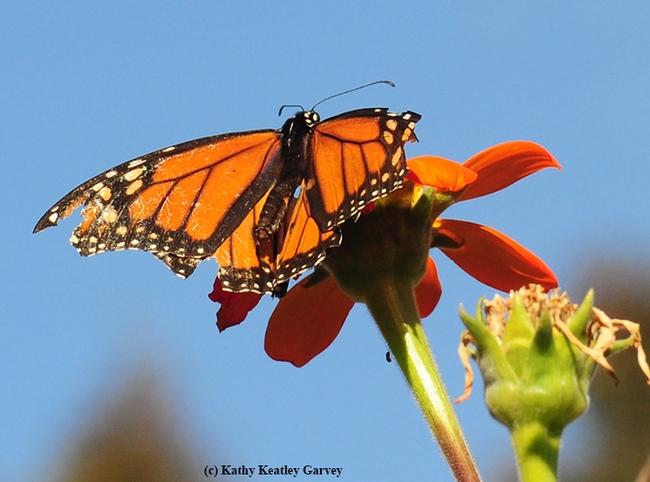

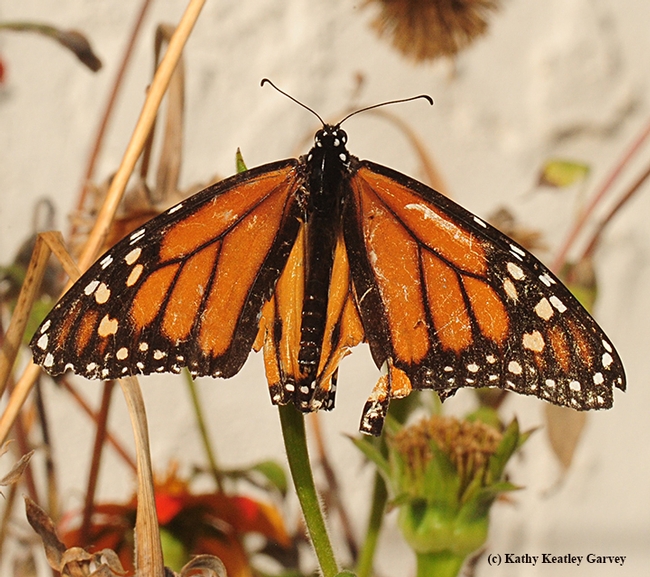

- Author: Kathy Keatley Garvey
How's your front yard looking?
A little bit brown due to the drought? Thinking of replacing some of your plants with drought-tolerant ones? And hoping to attract some bees, butterflies and other wildlife?
You're in luck. The UC Davis Arboretum is planning its next public plant sale this Saturday, Oct. 11. The theme is, appropriately enough, "The New Front Yard."
The plant sale will take place in the UC Davis Arboretum Teaching Nursery on Garrod Drive. It's open to members only from 9 to 11 a.m. (but if you're not a member, you can join at the door), and it's open to the general public from 11 a.m. to 1 p.m.
UC Davis Arboretum officials point out that many homeowners want to replace "high-water use plants with low-water alternatives" and they're going to help you. "We are going to have the area's largest selection of attractive, drought-tolerant, easy-care, region-appropriate plants including lots of California natives and Arboretum All-Stars."
They've published a list of some "attractive, region-appropriate plants that save water and support wildlife," complete with botanical names and photos. (Download PDF)
They include California buckeye, manzanitas, California pipevine, narrow leaf milkweed, Frikart's aster, Caliifornia aster, coyote brush, creeping Oregon grape, Blonde ambition blue grama grass, western spicebush, concha Ceanothus, Ray Hartman's California lilac, western red bud, Island mountain mahogany, California fuchsia, California buckwheat, St. Catherine's lace, coast silktassel, salt heliotrope, toyon, purple lantana, Goodwin Creek lavender, cape weed, monkey flower, deergrass, Hopley's purple oregano, Santa Margarita foothill penstemon, hollyleaf cherry, blue oak, California coffeeberry, pink chaparral currant, flowering currant, Santa Catalina Island currant, white sage, Cleveland sage, autumn sage, Santa Barbara sage, Cascade Creek California goldenrod, alkali sacaton, yellow autumn crocus and Roger's red grape.
Those are just a few of the plants they're offering for the plant sale.
Ah, so many choices, so little space. And one of the best parts? The bees and butterflies and other pollinators they attract.




- Author: Kathy Keatley Garvey
There's something about seeing a butterfly that makes your eyes light up, your smile widen, and your feet feel like skipping.
Nature's joy.
So when I was over at Kaiser Permanente in Vacaville last Tuesday, I rejoiced at seeing a magnificent anise swallowtail, Papilo zelicaon, fluttering around the lantana flower beds near the entrance.
The butterfly flashed its brilliant yellow and black colors in the morning sun as it glided around the flower bed, touching down occasionally for a sip of nectar.
Such a beautiful, awe-inspiring, glorious creature.
So I did what comes naturally—I pulled the camera out of my bag—somewhat like pulling the rabbit out of a hat because you never know what kind of magic may--or may not--happen. Assuming my best "non-predator posture," I slowly trailed it from blossom to blossom, dropping down to capture its image.
It was then that I noticed a woman sitting on a nearby bench, smiling, as she watched the photographer follow the butterfly.
“I love butterflies," she said. "I collect butterflies—jewelry. I would never collect the real thing. They're too beautiful.”
“Me, either,” I said. “I try not to disturb them—I just photograph them.”
Half an hour later, I returned to the area only to observe a stricken look on the woman's face.
“You have the last photo of that beautiful butterfly," she said. "A bird ate it."
And right in front of the managed health care facility.
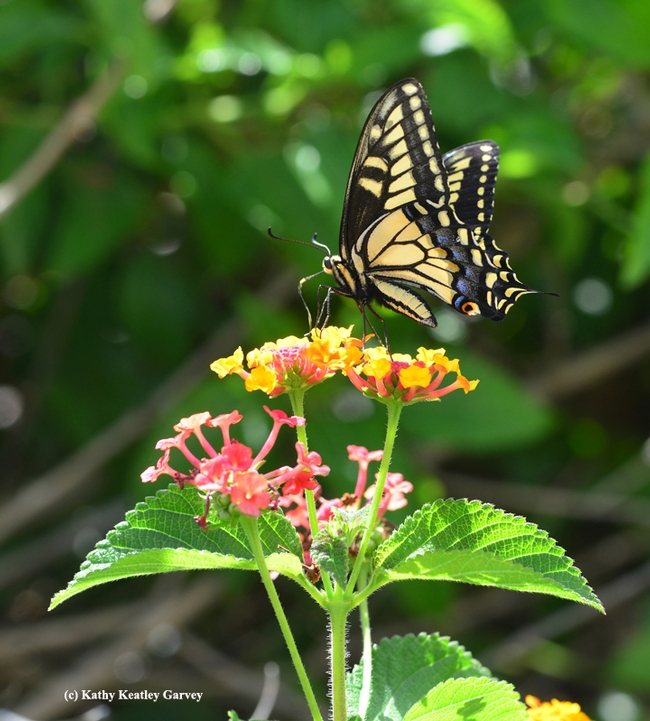
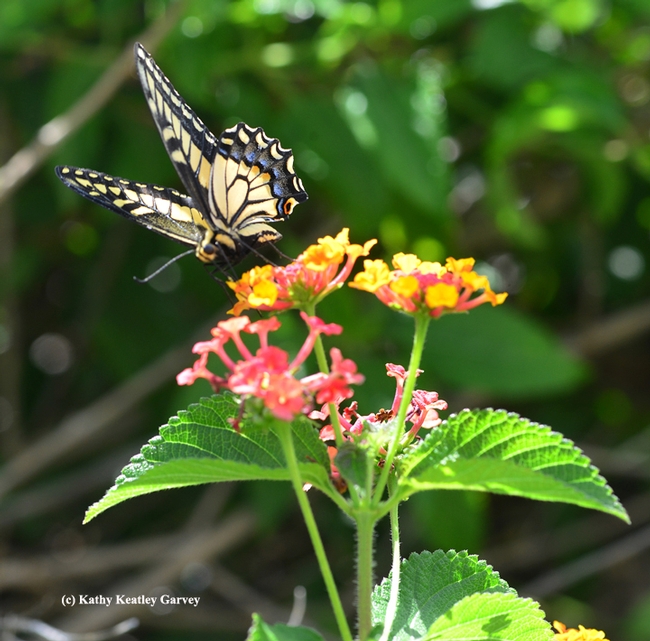

- Author: Kathy Keatley Garvey
First the lantana, and then the passion flower vine.
The Gulf Fritillary butterflies (Agraulis vanillae) flutter daily around our backyard. They stop for a little nectar from lantana (family Verbenaceae), and then head over to the passion flower vines (genus Passiflora) to breed or lay their eggs.
You can't miss them. The Gulf Frit is a showy, reddish-orange butterfly. Its underside absolutely sparkles in a spangled iridescent silver.
Butterfly expert Art Shapiro, professor of evolution and ecology at the University of California, Davis, and who maintains the website, Art's Butterfly World, says the Gulf Frit was introduced into southern California in the 19th century and first recorded in the Bay Area "before 1908."
It was once prevalent in the Sacramento area in the 1960s, but seemed to have died out by the early 1970s.
Then in 2009, it began making a comeback in the Sacramento area.
It's definitely making a comeback. A beautiful comeback.



- Author: Kathy Keatley Garvey
Ah, the Gulf Fritillary...
We spotted this orange-reddish butterfly nectaring lantana last Saturday near downtown Vacaville. In fact, the patch of lantana (family Verbenaceae) drew assorted butterflies, including buckeyes, alfalfa, monarchs, and painted ladies. A few honey bees and native bees tried to get their share.
Lantana and Gulf Frits. These multi-colored blossoms and the multi-colored butterfly, both found in the tropics and subtropics, are a study in brilliance.
On his website, butterfly expert Art Shapiro, professor of evolution and ecology at the University of California, Davis, says the Gulf Frit (Agraulis vanillae) was introduced into southern California in the 19th century, and was first recorded in the Bay Area before 1908. Once prevalent in the Sacramento area in the 1960s, it "seems to have died out by the early 1970s," he said.
Then in 2009, it began making a comeback in the Sacramento area.
Now it appears to be thriving in some areas, at least where its adopted host plant, the passion flower vine (genus Passiflora), grows. If you have a passion flower vine in your yard, you may very well see the spiny orange-and-black caterpillars feeding on the leaves. And if you have lantana or Mexican sunflower (Tithonia) in your yard, don't be surprised if a few adults drop by for a sip of nectar.
No wonder that commercial companies mass-rear these exotic-looking butterflies for release at weddings, garden parties and other social events.


